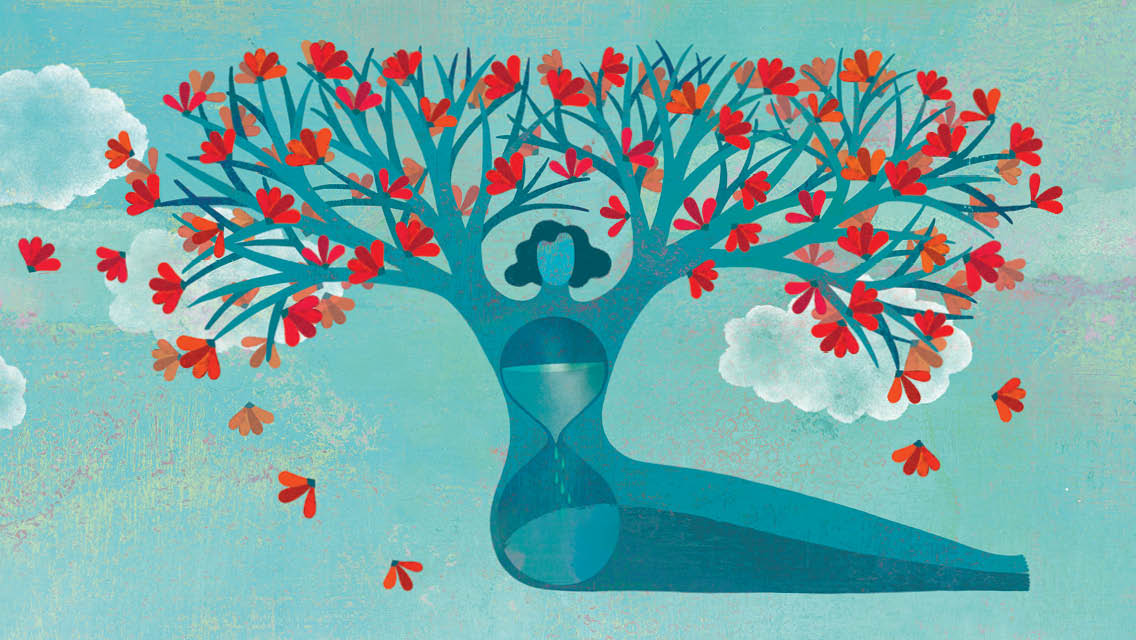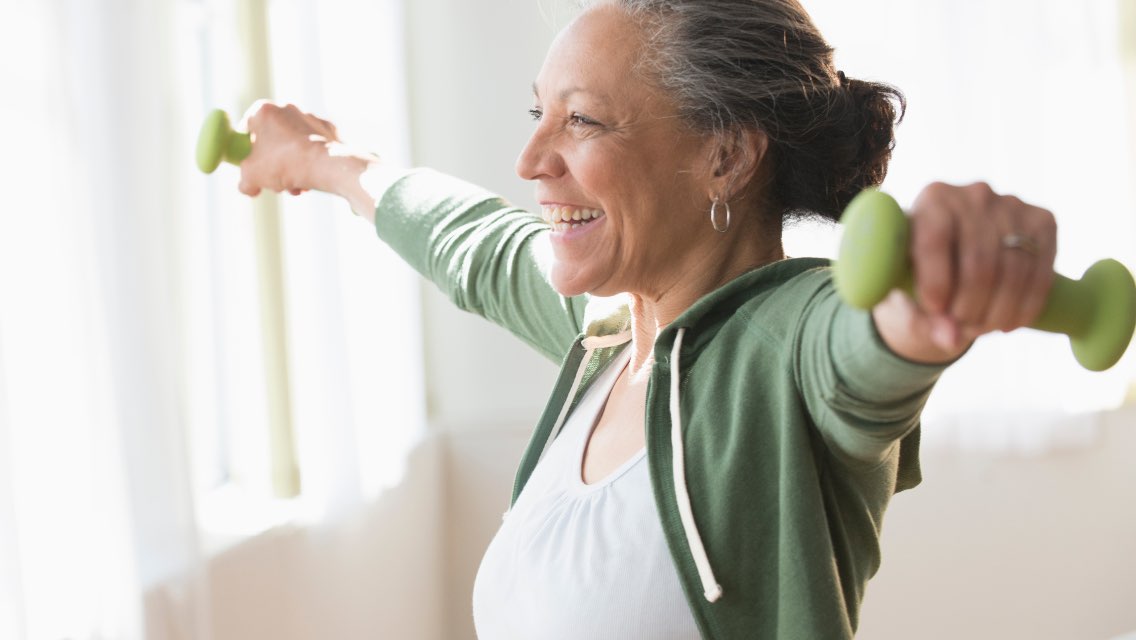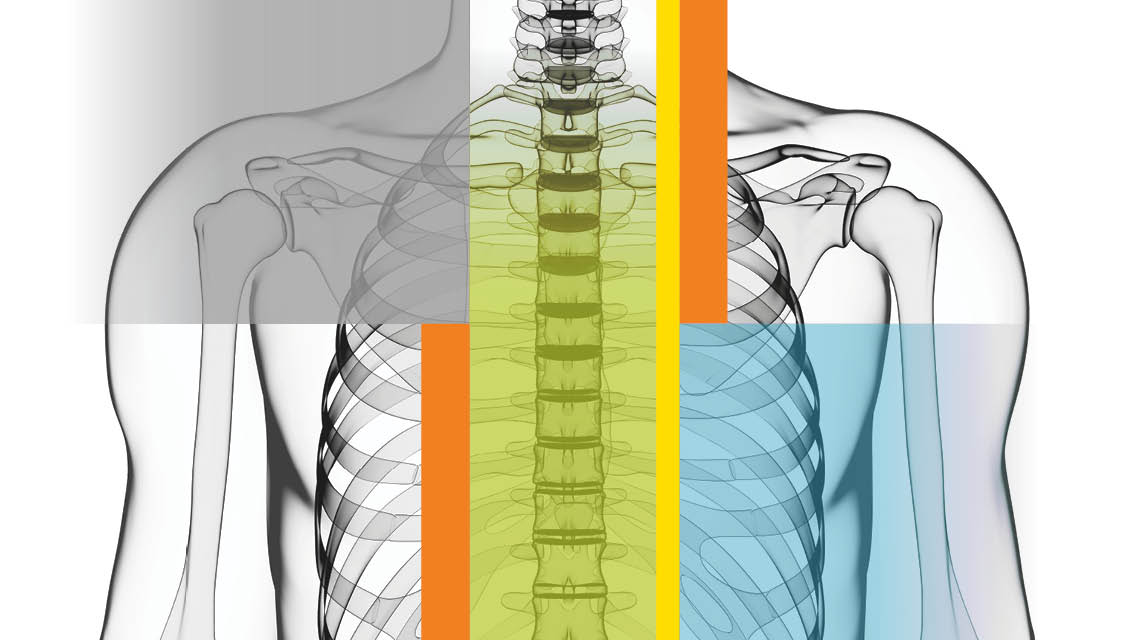Though it was February in Minnesota, Shailene kept waking up hot and sweaty in the middle of the night. She was sure something was wrong with the furnace.
After her spouse checked and confirmed that the furnace was in perfect working order, it dawned on her that she was having her first hot flashes. Shailene was in her late 40s, so the timing made sense — it just hadn’t occurred to her until that moment that she could be starting menopause.
This story was told at a friend’s 50th birthday dinner, and here’s the punchline: Shailene is a physician who specializes in women’s health. Even with her professional training and years of experience, the changes in her own body caught her off guard; physicians are not immune to the information vacuum here.
Enter menopause: the hormonal transition that dare not speak its name. Right now, more than 60 million American women are in the midst of perimenopause (the two- to six-year period that precedes the end of menstruation) or menopause (its actual cessation).
Yet most healthcare providers, including gynecologists, may receive only one or two lectures about menopause during their medical training. This leaves most women to face these changes without much guidance from their doctors.
“Up until recently, menopause was invisible,” says Heather Hirsch, MD, MS, NCMP, clinical program director of the Menopause and Midlife Clinic at Boston’s Brigham and Women’s Hospital.
This can be true in social circles as well. Many women feel embarrassed by menopause and try to tough it out privately; forget asking for advice from friends or family.
Yet going through menopause in isolation can make a potentially rocky transition more difficult. “Thinking a weird body thing is uniquely yours is very disempowering,” notes obstetrician and gynecologist Jen Gunter, MD, in her book The Menopause Manifesto.
She’s found that knowledge helps. “Many women are relieved simply to know their experiences are common and expected.”
Understanding menopause for what it is — a normal, if occasionally disruptive, hormonal transition — can also help ease some of its emotional stresses. Aviva Romm, MD, an integrative-medicine physician, women’s-health specialist, and author of Hormone Intelligence, recognizes that menopause symptoms can be difficult to embrace, especially given the historical cultural stereotypes.
Still, she encourages her patients to challenge the destructive myths about inevitable decline. Many women find that they feel freed by the end of their periods and the changes in their hormones. “Menopause is not a time when your fire has gone out,” says Romm. “You actually have a beautiful pilot light inside of you.”
No matter where you are on your own hormonal trajectory, it’s worthwhile to have reliable information about menopause so you don’t have to experience this transition in the dark. To that end, these are some answers to common questions.
What is menopause?
Menopause is a natural event marking the end of the reproductive phase in a woman’s life, signaled by the end of menstruation. It becomes official after a full 12 months have passed without a menstrual period.
This normal part of female aging usually occurs between the ages of 45 and 55; the average age is 51. Menopause before 45 is considered “early menopause,” according to the Cleveland Clinic; before age 40 is “premature menopause.”
Menopause is a natural event marking the end of the reproductive phase in a woman’s life, signaled by the end of menstruation.
Early menopause may be induced surgically, by removal of the ovaries, or chemically, with medications, such as chemotherapy, radiation, or those used to hold hormone-receptive breast cancer at bay. (Periods that stop before age 40 without medical intervention are sometimes called “primary ovarian insufficiency”; if your periods stop this early, check with your healthcare provider to rule out other complicating health factors.)
Once someone passes the one-year mark without a period, they are technically postmenopausal — though some health experts think that term is misleading. “I’m a fan of using the word ‘menopause’ to encompass the whole continuum or experience, from the menopause transition onward,” Gunter explains, since health symptoms associated with menopause “don’t magically start or stop with the final period.”
And while these hormonal shifts can present themselves in some unsettling ways — hot flashes, moodiness, sleeplessness, forgetfulness, and a hide-and-seek libido — this is all par for the course. “Menopause is not a disease,” notes Gunter. “It is an evolutionary adaptation that is a part of the survival of the species.”
Why does menopause happen?
The technical reason is that the ovaries run out of viable eggs; the evolutionary reason is less clear. Humans are one of only five species known to enter menopause; the others are orcas, pilot whales, belugas, and narwhals. All of these species have relatively lengthy life spans.
Among whales, menopausal females are also uniquely helpful to the survival of newborns and their mothers. This is known as the “grandmother hypothesis”: Nonreproducing female whales have more experience finding food and less need of it, so they can provide wisdom and support for their reproducing daughters while requiring fewer resources for themselves.
What’s going on hormonally?
During the reproductive phase, ovaries produce a fertilizable egg on a more-or-less monthly cycle. This process is governed primarily by estrogen, which is involved in the release of the egg, and progesterone, which prepares the uterus for possible implantation.
The human female body is born with a finite number of eggs, so after enough menstrual cycles, the ovaries begin to run out, and cycles stop. On the way to this point, levels of estrogen and progesterone behave erratically, occasionally surging as they decline in fits and starts — the hallmark of perimenopause. You might feel like you’re riding a hormonal roller coaster because that’s exactly what’s happening.
But Romm notes that estrogen does not disappear. “During what are called our reproductive years, we produce primarily estradiol, which is a potent form of estrogen,” she explains. “Then, when we transition into menopause, we primarily make estrone. We still have estrogen — it’s just a different, less potent form that doesn’t stimulate reproduction, but it is keeping our hearts and brains healthy and doing other things.”
What is perimenopause?
All these hormone shifts don’t happen overnight. Perimenopause usually begins somewhere in the early to mid-40s. Cycles can become unpredictable and may be much heavier or lighter, and symptoms such as hot flashes may begin to set in.
Perimenopause can be bewildering, because menstrual periods continue, and we often think of menopause as the time when periods end. Yet many of the symptoms associated with menopause are at their worst during this transitional stage. “If you are in your menopause transition and experiencing that hormonal chaos, know for many women this is the rockiest phase,” Gunter notes.
Meanwhile, some women barely register a blip. Everyone is different. That said, biological mothers and daughters often find that their menopause begins at or around the same age.
What Are the Most Common Signs of the Menopausal Transition?
Technically, menopause is the cessation of periods for 12 months, but as you’ve gathered by now, we’re talking about a process. Because estrogen plays a role in keeping many of the body’s systems running smoothly, its decline can contribute to many of the irksome symptoms of the menopausal transition.
Weight Gain
Many women notice that their clothes begin to fit differently after age 40, even if their diet and exercise habits remain the same. According to functional-medicine physician Sara Gottfried, MD, author of The Hormone Cure, this is because the rate of fat gain increases as estrogen declines, and much of this fat will be stored at the waist, as fat-distribution patterns also change. When hormones level out after menopause, the weight gain typically stops.
While the weight itself is not a health issue, Gottfried notes that it can correlate with metabolic-health challenges, including a greater risk for heart disease, high blood pressure, and problems with insulin regulation.
Try this: Gottfried suggests a modified ketogenic protocol (unlike strict keto, her approach includes a modest amount of carbohydrates) and intermittent fasting (IF) to help her patients manage their hormones, including insulin and cortisol, and stabilize their weight.
Romm, meanwhile, suggests a cautious approach to IF. “For some women it can help,” she says, but she’s concerned that effects may diminish after six to eight weeks. Fasting can also have rebound effects on blood sugar and weight, she adds, “so maybe do it a couple of days a week instead of all the time.” (For more on fasting, see “Everything You Need to Know About Intermittent Fasting“.)
Sleeplessness
With or without night sweats, disrupted sleep is a problem for many women during perimenopause. Again, this has to do with hormonal changes. Melatonin, the hormone that regulates sleep timing, decreases naturally with age, Romm explains.
What’s more, melatonin is produced from serotonin, which is also related to estrogen production; some research suggests that as estrogen declines, so does melatonin. These shifts are normal, she emphasizes, but they do set up a “triple hormonal whammy.”
Try this: Romm, a trained herbalist, recommends a sleep-supporting cocktail of three herbal tinctures: passionflower, valerian root, and lemon balm. During a phase of rough sleep, take 20 to 45 drops of any or all of these a half-hour before bed, and then again 15 minutes before lights out.
Place a third dose on the nightstand in case you wake up in the middle of the night.
Hot Flashes
Vasomotor symptoms, colloquially known as hot flashes, are the signature symptom of perimenopause and menopause. They can be triggered by a warm room, a stressful situation, or nothing at all, and typically they last from one to five minutes. They may feel like a warm flush or a full-blown conflagration, which makes you want to immediately strip down to your tank top in a room full of people in sweaters.
Sixty to 85 percent of women experience hot flashes, and frequency may be correlated with race, with African American women reporting the greatest number of episodes. Researchers remain at a loss for why this is so.
Try this: For immediate relief during a hot flash, Gottfried recommends this breathing exercise: Take a five-second inhale, 10-second hold, and five-second exhale. Repeat until you cool down.
Other strategies include wearing layers you can remove as needed, keeping the bedroom cool at night, and avoiding spicy foods and alcohol if these are triggers for you. (Red wine, notes Romm, can be one of the worst culprits.)
Severe or chronic hot flashes can signal a greater risk for cardiovascular disease. If this is the case, work with your healthcare provider on heart-health protective strategies, such as smoking cessation and dietary changes. (For more on heart health, see “Rethinking Heart Health“.)
Anxiety and Mood Swings
These are familiar PMS symptoms as well as routine features of the menopausal transition. In both cases, the abrupt shift in hormone levels can tank mood. Like estrogen, progesterone also drops (though more gradually); this hormone typically has a calming effect. When progesterone goes down, it can be “harder to soothe yourself,” explains Gottfried.
Try this: You know better than anyone else what helps you manage your mood in a healthy way. Is it a yoga practice? Playing guitar? Long solo walks? Start there.
At a minimum, consider adopting a nonnegotiable daily movement practice, and keep a few calming herbal interventions on hand, such as kava, ashwagandha, or CBD.
Memory Loss
As hormones begin to shift, many women find themselves struggling with word recall and other short-term memory tasks. This may be caused by the hormonal switch from the more potent estradiol, which plays a role in brain function, to estrone, the less-potent form of estrogen.
Happily, this effect seems to be temporary, according to one study that followed 2,362 perimenopausal women for four years. Once the menopausal transition concluded, these cognitive issues disappeared.
Try this: Rhodiola, an adaptogenic herb, can help with mental clarity and focus. A sense of humor is also handy.
Declining Libido and Changes in Vaginal Health
Throughout the reproductive phase, estrogen helps foster interest in sex, and when estrogen declines, so can libido. Estrogen also plays a prominent role in keeping the tissues of the vagina healthy, and accordingly, they can become drier and thinner as the hormone declines.
These changes also involve structures beyond the vagina, including the bladder, urethra, and vulva; medically, this is known as genitourinary syndrome of menopause, or GUSM. It can make intercourse uncomfortable or painful and bring on a more frequent need to pee. As symptoms go, this group may get the Biggest Bummer award. (There are many reasons why women chronically experience pain during intercourse. See “14 Reasons Why Sex Might Be Painful for Women” for more.)
Try this: Regular walks support blood flow. Adding flaxseeds and soy foods (for the phytoestrogens) can help relieve vaginal dryness. Regular sexual activity (using additional lubrication as needed) may be the best way to maintain elasticity.
Be willing to experiment. “Sometimes a small adjustment creates big changes,” notes Gottfried. “I love it when a patient realizes that she can alter her presumed life-sentence of low sex drive with a particular form of meditation, like orgasmic meditation.”
What Can I Do to Make Perimenopause and Menopause Easier?
Though everyone will have her own unique path through menopause, the following interventions are useful across the board.
Exercise
Strength training is vital here. Women and men both experience muscle loss, or sarcopenia, over time, so maintenance is key.
“We’ve got to preserve the muscle we have, and to do that we’ve got to take action,” says Amanda Thebe, a certified personal trainer who focuses on menopause and health. She suggests starting a strength-training regimen that builds up to 30 to 40 minutes, three times a week. It’s OK to start small and build up over time.
Strength training is any exercise that taps either body weight or equipment, such as free weights and resistance bands, to stimulate muscle growth.
In addition to this, Thebe recommends daily movement. “It’s so important for our overall health, and the easiest way to do this is to pop on your sneakers and get outside for a walk.”
Gottfried notes that a regular yoga practice can help offset specific menopause symptoms, such as hot flashes and moodiness.
Protect Your Sleep
Sleep is vital to general health and mood regulation. Make it a priority, and resist the temptation to skimp.
Get serious about sleep hygiene: no phones or TV in the bedroom, keep the room dark and cool, practice a wind-down routine during the last hour of the day. Keep herbs like valerian root on hand for difficult sleep phases. (For more sleep tips, see “5 Evening Routines for Better Sleep“.)
Focus on Diet and Gut Health
A whole-food, vegetable-centric, easy-on-the-sugar diet helps regulate blood sugar, supports weight stability, and provides enough fiber to keep the microbiome happy and humming — which is good news for the gut–brain connection. “The gut–brain axis puts gut function at the center of any mood, weight, and energy issue that a woman faces,” notes Gottfried.
Romm emphasizes the importance of getting “plenty of fiber, both for micronutrients and gut health.” She recommends following the Mediterranean diet, which is heavy on vegetables and light on animal protein. Any of the many traditional diets that emphasize vegetables, healthy fats, and legumes will do. (Learn more about these benefits at “5 Heritage Diets and Their Health Benefits“.)
She also suggests limiting simple carbohydrates and sticking mainly to nongrain seeds, such as buck-wheat, millet, and quinoa. “Another great go-to is flaxseeds,” she adds. “Use them in your oatmeal and your smoothies. They help with estrogen and progesterone levels, and are a phenomenal fiber, so you get all the great gut benefits.” She recommends a tablespoon or so per day.
Go Easy on Coffee and Booze
Coffee can offer some neuroprotective effects, Romm says, but caffeine can amplify anxiety; one cup a day is plenty.
Meanwhile, wine can worsen reflux (increased reflux is part of aging) and disrupt sleep. Relinquishing your nightly glass will be worth the rewards. Save it for special occasions. For the occasional cocktail, Romm suggests vodka — it’s the least sleep-disruptive. Just keep it to one drink.
Try Herbal-Supplement Support
Many women find that certain herbs help downshift menopause symptoms. Maca root, for example, can raise estradiol levels in menopausal women, mitigating a variety of symptoms, including vaginal dryness and memory loss, Gottfried notes. Just add a teaspoon of maca-root powder to a smoothie or yogurt.
Romm is a fan of the plant chasteberry. “It can help improve both estrogen and progesterone levels and is shown to help with hot flashes, mood shifts, and sleep.”
She suggests a different approach for women with a history of estrogen receptor-positive breast cancer. “If that’s the case, use black cohosh, which also has a lot of benefits but doesn’t increase estrogen levels.”
Both herbs are available in tincture and capsule form.
Talk to Your Friends
One of the most comforting resources during the menopause transition is other people — those who’ve gone through it, or who are going through it too. “It’s so normalizing to talk to other women about it,” says Romm.
It’s also helpful to share the positive changes that accompany menopause, even as you process what you’re letting go. “It’s natural to mourn a phase that has passed, like when you marry, you might mourn your single life,” offers Romm. “But it’s important to remember that you will spend the next 30 to 40 years in menopause. This is a new phase.
“What is this going to look like? How are we going to embrace this? This is a chance to feel liberated from the expectations of others and embrace what it is that we are here to do,” she says. “We are old enough now to do what we want.”
What About Hormone Replacement?
Some women turn to hormone replacement therapy (HRT) to ease the menopausal transition. Using synthetic hormones to replace declining estrogen has a decades-long history.
After early research by the landmark Nurses’ Health Study suggested that HRT might increase risk of breast cancer, many people shied away from it. Concerns that it increases cancer risk have since been mostly disproven, but integrative physicians Sara Gottfried, MD, and Aviva Romm, MD, recommend building a solid foundation of lifestyle interventions before turning to this option.
For Gottfried, hormonal therapies are the third and last step — after lifestyle and herbal solutions — in her sequential approach to hormone balancing. Romm takes a similar approach, noting that even bioidentical hormones (which are often marketed as a gentler alternative) are still serious medication.
Still, Romm sees HRT as a good option if the menopause symptoms for which these drugs are indicated are seriously affecting your quality of life. “Be cautious but not shy if HRT is going to help your well-being,” she says.
For many women who have done all they can with lifestyle and diet, HRT marks the difference between manageable and unmanageable symptoms — and quality of life matters.






This Post Has One Comment
Excellent article — and perfect timing to share with my daughter as she enters this time in her life. It’s important to remember that it’s a natural phase of our lives. The more you embrace your personal experience, the less disruptive it may feel.